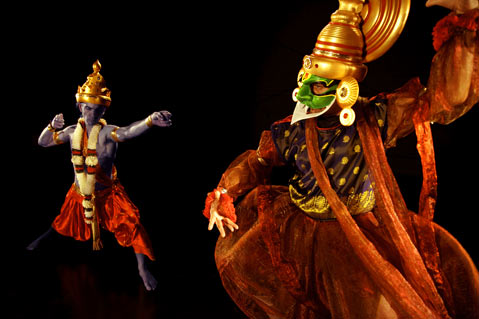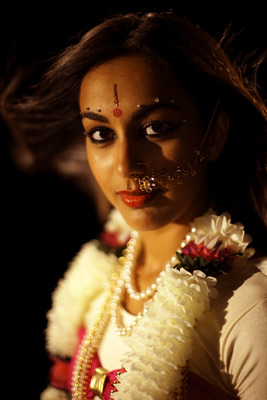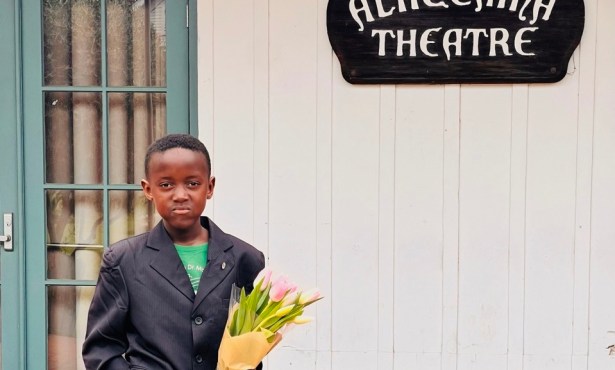Boxtales Theatre Company Premieres Om: An Indian Tale of Good and Evil
New Show Incorporates Yoga, Acrobatics

There’s nothing more central to human nature than the need for a good story. Here in the 21st-century Western world, we feed ourselves on tales of adventure, flocking to futuristic films like Star Wars and devouring fantasy novels with heroes like Frodo Baggins and Harry Potter. But as Joseph Campbell reminded us, myths and legends are far more than entertainment; they are our way of explaining the meaning of life, of expressing universal truths, and reminding ourselves of our common humanity.
For Boxtales Theatre Company leaders Michael Andrews, Jeff Mills, and Matt Tavianini, storytelling is what it’s all about, and a good show always begins with a great legend. They’ve found just that in the Ramayana, one of India’s ancient epic poems and a living religious text that continues to inform Hindu spirituality and daily life, reaching across caste, region, and language barriers. Next Thursday, October 1, Boxtales will premiere Om: An Indian Tale of Good and Evil, a show that’s based on the Ramayana. It’s the company’s biggest, most ambitious production to date, and it’s got all the makings of a classic adventure story: heroes and heroines, demons and tyrannical rulers, family feuds and gender issues, and scenes that raise questions about the nature of love, power, and morality. As Andrews said recently, “I know a lot of stories, and I don’t think I’ve ever found a story I like better.”

The company’s last stage production was its 2007 adaptation of Homer’s Odyssey, another epic tale of heroism and adventure. In the intervening years, Mills has been teaching movement for actors at UCSB, where through exercises and improvisation, BFA students have become increasingly familiar with Boxtales’ unique aesthetic, style, and methodology. The 12-strong cast of Om includes three current students of the UCSB program and four recent graduates. Among the other performers is Odyssey cast member and yoga instructor Jenny Sauer-Klein, whom Andrews, Mills, and Tavianini credit with introducing Boxtales to a whole new level of physical storytelling.
Since its inception in 1994 as a storytelling and performance group that toured Santa Barbara’s schools, Boxtales has thought of itself as a movement theater company, using mime, mask work, ethnic dance, and even martial arts to bring stories to life. But for the past few years under Sauer-Klein’s influence, the company has also begun to integrate yoga into its training and rehearsals. Sauer-Klein teaches circus skills and is the cofounder of AcroYoga, a combination of partner yoga and acrobatics that involves weight sharing and features spectacular balances, flips, and contortions. With Om, AcroYoga has made its way to the stage.
“This will go down in history as our yoga show,” Mills predicted. “One of my early resistances was, ‘I’m not sure I really want to do a yoga show.’ But it has become something that’s really rooted and important to us.” “Our community’s sense of yoga is basically asanas, or poses,” Andrews added, “but there’s a lot more to yoga than that. Right words and right actions come from yoga, too. We hope all of that will be in the show without hitting anyone over the head with a metaphorical frying pan.”
Learning to live a more principled life through practicing yoga is a bit of a heady concept for a family theater production, but Boxtales isn’t known for taking on light and fluffy pieces; the company’s been called “the thinking man’s Cirque du Soleil.” True to form, Boxtales’ artists have immersed themselves in the story of the Ramayana. In June, Mills and Andrews traveled to a training center near Bangalore, India, to take part in a three-week theater workshop that incorporated Indian dance and martial arts, yoga, and carnatic music, as well as lessons on the social, political, and cultural history of India. On their return, they gathered their cast and gave each member an English translation of the Ramayana.
It’s a tale that begins, as all great stories do, with a hero in conflict. Rama, the king’s eldest son and the protagonist of the story, is chosen to succeed his father to the throne, but Rama’s stepmother interferes, holding the king to an oath made years before and forcing him to banish Rama to the forest. The tale follows the morally upright Rama and his wife, Sita, as they face a series of trials and challenges, never stooping to selfish or hurtful means.
Rather than starting from the text, as a more traditional theater company might have, Boxtales began rehearsals with physical improvisation. Using an outline that Andrews, Mills, and Tavianini had prepared, they went straight for the scenes that could be conveyed with the body. “It’s a matter of being economical in terms of what we wanted to dedicate time to and what scenes we wanted to do more quickly through visual storytelling,” explained Allie Menzimer, a recent UCSB graduate and cast member who also wrote the script for Om. In preparation for the project, Menzimer read various translations of the Ramayana, then went to work crafting a version that would make the story vivid and accessible to a Western audience while staying true to the story’s themes. At a rehearsal on the Lobero stage last week, Menzimer and two other young women kneeled downstage center, wearing sparkling headscarves, their hands arranged in mudras to suggest childbirth and babies. They represented the three wives of King Dasharatha, the father of Rama. Behind them, Sauer-Klein whinnied and pawed at the ground, lifting her knees high and shaking her head from side to side. Across the stage, Andrews wore a golden crown and used his whole body to tug on an invisible rope: a king pulling his horse toward him. Upstage left, on a low platform, Montino Bourbon stood playing a sarod-a stringed instrument popular in classical Indian music-while a speaker at his feet projected a pre-recorded soundtrack of cymbals and hand drums, with occasional interludes of guitar and bass. Bourbon will perform at every show, making this the first time Boxtales has developed work alongside a dedicated composer and musician. “The music is my own creation, but I’m following the Indian musical tradition because it’s really good for creating moods,” explained Bourbon, a longtime student of the late, legendary Hindustani musician Ali Akbar Khan. “Whether it’s anger or joy, the musical interludes are based in emotion.”
Though the show is steeped in ancient traditions and aims to inspire audiences to examine their own codes of morality, the performers are also having a lot of fun with the process. During a rehearsal last week, they rolled their eyes when they forgot their lines, spoke to one another in mock Indian accents, and gave each other high fives with every successful acrobatic maneuver. Some of the men took turns “flying” from cables suspended above the stage, while two women practiced a slow-motion back flip that kept resulting in tangled costumes. Each new gaffe elicited more laughter than anxiety. With only a few days to go until opening night, rehearsals were still a democratic process of exploration and discovery, with plenty of hugs and humor thrown in. It was as if the performers had begun to take the lessons of the Ramayana to heart, and like Rama himself, face a great challenge with equanimity, strength, and grace.
4*1*1
Boxtales Theatre Company, in association with Theater UCSB, presents Om at the Lobero Theatre (33 E. Canon Perdido St.) from October 1-4. For tickets, call 963-0761 or visit lobero.com. For more about Boxtales, check out boxtales.org.



